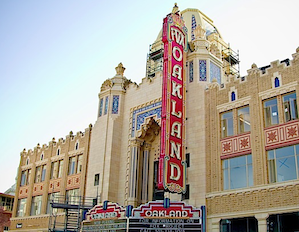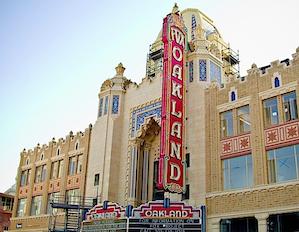Kids Around the Bay now includes descriptions of school music programs in the greater Bay Area. It’s an effort to provide parents with a sense of the resources and philosophy offered by different schools. This week we spoke with Donn Harris, principal of Oakland School for the Arts, a charter school created in 2000 that includes both a middle school and a high school. Arts include Dance, Digital Media, Instrumental Music, Literary Arts, Theatre, Vocal Music, Visual Arts, Circus Arts, and Production Design.
In 2007, Donn Harris, then principal of what is now called the Ruth Asawa San Francisco School of the Arts, was asked by Oakland Mayor Jerry Brown to take over Oakland School for the Arts. As Harris remembers it, he was chosen because of his reputation as an administrative troubleshooter, about whom it was said, if you’ve got a problem, get that guy from San Francisco.
“A lot of people have the idea that to start one of these schools you just come up with an approach and draw up a document,” says Harris. “That’s the easy part; what’s much harder is knowing how to run a school — how to combine vision, purpose, and values. Just having a great idea for a school is not enough.”
Harris holds the positions of both executive director and artistic director, but he says most of his time these days is spent raising money. Right now he’s trying to raise $500,000.
“A lot of people have the idea that to start one of these schools you just come up with an approach and draw up a document. That’s the easy part.” – Donn Harris, principal In the five years Harris has been in Oakland he has doubled the number of students, to 600, and has fostered a sixth through twelfth-grade magnet school with a 96 percent graduation rate. Of that number two-thirds go on to a four-year college.
“We’ve got kids going into engineering, psychology, as well as the music arts; we’re not training every kid to be an artist. Here’s a case study. We had a dancer not along ago who was with us from sixth through twelfth grade. Super hard working, very talented, was waitlisted at Julliard. In the end, he wasn't’ offered a spot but he got into the Cornell school of hotel management and minors in dance. He didn’t quite get to where he wanted, but minoring in dance at an Ivy League school is still a great accomplishment.”Here is a world view I would offer: We see innovation and spontaneity as the cornerstones of a modern education, as opposed to simply the narrow world of data analysis and test scores. And so we’ve created a very free atmosphere founded on music and creativity. At OSA you don’t have to have hall passes, for example. We trust students to do the right thing and our success is proof that that approach works. In the end, I think the degree to which kids succeed comes largely from their ability to be spontaneous and to innovate. Just as we’re talking, right outside my office I can hear two students arguing over a political point of view they’d heard in a poetry reading. Our whole effort is to set up environments that encourage that exchange.”

There are perhaps 200 schools like OSA across the country and according to Harris they all look surprisingly alike. The original model was the Fiorello H. LaGuardia High School, popularized in the 1980 film Fame. All applicants must audition for admission to OSA, which for the youngest students involves playing scales, playing or singing a song that they’ve rehearsed, and demonstrating ability to sight-read. All new students must pick an art form to study, although they can adjust their focus at a later point. About one third of the students are involved in music, either in the instrumental or the choral program. A good number of those students go on to study music at such places as the Berkelee School of Music, the University of Michigan, and New York University.
Because OSA is a charter school, music teachers are not required to have state teaching credentials, which means that teachers tend to be more diverse as well as being working musicians. “Basically,” says Harris, “our faculty is made up of working artists and teachers.”
He added that one misconception about schools like OSA is that they cater to the elite and kids of privilege. “That could not be more untrue here. We’re trying to get kids from all parts of the area, and if parents have a child in the third grade who’s a great artist and but doesn’t have access to classes on their own, we will fill in those gaps. They can come to us after school and sit in our classes or get portfolio help. Or in some case we can even go to them. I want to make it very clear that we don’t want OSA to be an elitist school.”
Asked how OSA differs from the San Francisco School of the Arts, Harris replied, “For the most part they’re structurally similar, although SOTA doesn’t have a middle school. The schedules and auditioning process are also similar. As a generality I would say Oakland offers a more diverse student body. In terms of music, I’m not sure we’re as robust in some of the music programs as SOTA, but we are certainly comparable overall.”
Spreading the Joy in the Public Schools
How much difference does music make in the lives of public school students in San Francisco? That was the question we posed to two teachers: Peter Sroka, a music teacher and Marci Ryan, who teaches special education classes to children in kindergarten to fifth grade at the Fairmount Elementary School.
“I’ve found that art and education really go hand in hand, and if you can convey a sense that learning is joyful, children will find all kinds of connections to things they might not otherwise have connected with.” – Peter Sroka, music teacher
Once a week Sroka, whose background is in music and theater and has an M.A. in International Education from Harvard, comes to Fairmount. “I’ve found that art and education really go hand in hand,” he told us the other day, “and if you can convey a sense that learning is joyful, children will find all kinds of connections to things they might not otherwise have connected with.”
Sroka appears in five schools each week and by all accounts has a miraculous ability to simultaneously entertain, teach, and endear himself to young students. He uses whatever is at hand to impart a lesson, whether about language, history, or values. He makes up songs on the fly. Here’s an example: “Be kind, be smart, eat well; shake that thing and don’t forget to sing.”
“He’s like Jim Carrey,” says Ryan, who has taught at Fairmount for three years. “Whenever he comes, the kids all get very excited. What he does so well is to enable the children to participate. It’s just so joyful and they really feel the rhythm.”
Ryan’s students suffer a variety of cognitive disabilities, including autism and cerebral palsy. Some wear tracheotomy tubes. “What I’ve found is that teaching through singing really works and whenever Peter comes to class and does his funny voices and his funny movements and makes up songs the children really respond. The truth is they do things with him that they don’t do if he’s not there. It always ends up being a show that they’re a part of….”

